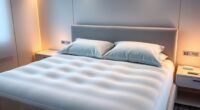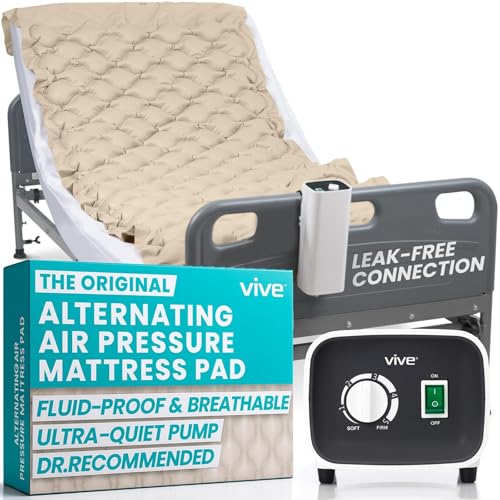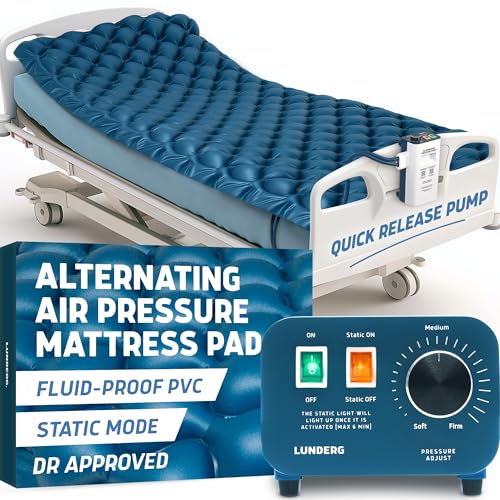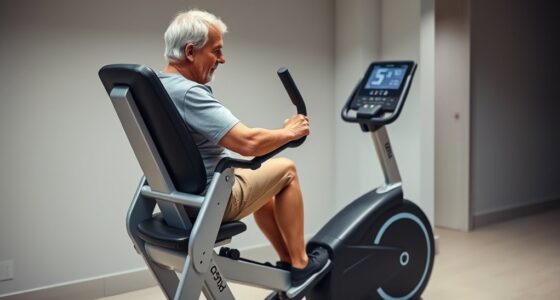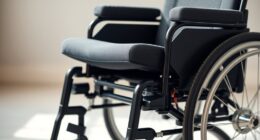If you’re looking for the best low air loss mattress systems for pressure relief and comfort, I recommend exploring models like the Vive Alternating Air Pressure Mattress Pad and the Drive Med-Aire system, which promote circulation and skin healing. Systems like MedVance and Invacare microAIR offer advanced pulsation therapy and customizable settings to suit individual needs. Keep in mind factors like support, durability, and safety features. If you continue, you’ll find detailed insights to help you choose the perfect option.
Key Takeaways
- Many systems feature alternating pressure technology with customizable cycle times to optimize pressure redistribution and enhance patient comfort.
- Quiet, reliable pumps with digital controls and diagnostic alarms ensure effective, safe, and user-friendly operation.
- High-quality, breathable, waterproof covers and moisture-wicking materials improve skin health and microclimate management.
- Support for heavy loads and various sizes accommodates different patient needs, providing tailored pressure relief and comfort.
- Advanced features like targeted therapy, microair pulsation, and adjustable modes promote superior pressure redistribution and skin protection.
Vive Alternating Air Pressure Mattress Pad
If you’re looking for an effective solution to prevent bed sores in immobilized or bedridden patients, the Vive Alternating Air Pressure Mattress Pad is an excellent choice. Designed to promote circulation and evenly distribute weight, it targets pressure points to reduce sores and ulcers. The mattress features 130 sealed air cells that alternately inflate and deflate, creating a wave-like therapy that enhances comfort. It supports up to 300 pounds, is waterproof, and quiet, ensuring restful sleep. Easy to secure on existing beds, it’s durable and hypoallergenic, making it ideal for long-term use. Trusted by caregivers, it provides reliable pressure relief and skin protection.
Best For: bedridden or immobilized patients at risk of developing bed sores who require reliable pressure relief and skin protection.
Pros:
- Effectively promotes circulation and prevents pressure ulcers with alternating therapy
- Quiet operation at 22 dBA ensures restful sleep without noise disturbance
- Durable, waterproof, and hypoallergenic design suitable for long-term use
Cons:
- Discontinued by the manufacturer, potentially limiting availability or warranty support
- Requires secure attachment to existing beds or mattresses to prevent slipping
- Limited to adult users and may not fit all bed sizes or types
Drive Medical Med-Aire Low Air Loss Mattress Replacement System
The Drive Medical Med-Aire Low Air Loss Mattress Replacement System stands out as an ideal choice for caregivers seeking to prevent and treat pressure ulcers in home or long-term care settings. It combines alternating pressure and low air loss functions to promote skin health and accelerate healing. Made in the USA with durable polycarbonate, it features 20 replaceable air bladders—nine with laser holes for cooling and microclimate control. The quiet pump supports up to 350 lbs, and safety alarms ensure consistent pressure. Its water-resistant, washable cover and portable design make it easy to maintain and transport, delivering reliable comfort and skin protection for patients.
Best For: caregivers and healthcare providers seeking an effective solution for preventing and treating pressure ulcers in home or long-term care environments.
Pros:
- Provides alternating pressure and low air loss functions to promote skin healing and comfort
- Made with durable, water-resistant materials and features replaceable air bladders for easy maintenance
- Equipped with safety alarms and a quiet pump supporting up to 350 lbs for reliable and safe operation
Cons:
- May require training to properly set up and operate the system
- The 10-minute cycle time might not suit all patient needs or preferences
- Bulkier design could be less portable compared to simpler mattresses
MedVance Low Air Loss Mattress Replacement System with Alarm
Designed for hospitals and care facilities, the MedVance Low Air Loss Mattress Replacement System with Alarm offers reliable pressure redistribution and patient comfort. Its 8-inch height fits most hospital beds and supports up to 450 pounds, accommodating various patient needs. The ultra-quiet, dual-core air pump (<20 dB) guarantees discreet operation, while the digital LED screen displays weight and pressure readings. With cell-on-cell design and an 8-inch deep air cell structure, it prevents bottoming out and provides up to 24 hours of power outage protection. Easy to use, with quick inflation, safety alarms, emergency deflation, and a removable, water-resistant cover, this system combines comfort with safety.
Best For: healthcare facilities and caregivers seeking a reliable, comfortable, and easy-to-use low air loss mattress system for patients up to 450 pounds.
Pros:
- Quiet operation (<20 dB) for discreet patient comfort
- Digital LED display for easy monitoring of pressure and weight
- Cell-on-cell design with 8-inch deep air cells to prevent bottoming out and provide up to 24 hours of outage protection
Cons:
- May require training for optimal use of digital controls and alarms
- Limited to hospital beds with specified dimensions; may not fit all bed types
- Dependence on electricity; backup power needed for extended outages
Vive 8″ Alternating Pressure Mattress
Looking for a reliable solution to prevent and treat pressure ulcers? The Vive 8″ Alternating Pressure Mattress is designed to do just that. It features 16 air chambers that evenly distribute pressure, reducing the risk of bedsores. The adjustable, ultra-quiet pump lets me customize inflation and deflation for maximum comfort. Its waterproof vinyl cover not only protects the mattress but also dissipates heat, keeping patients comfortable. Supporting up to 350 pounds, this mattress is durable and easy to maintain. With a 1-year pump guarantee and a 60-day mattress pad warranty, I feel confident in its quality and effectiveness for managing pressure relief needs.
Best For: individuals at risk of pressure ulcers or bedsores, especially those with limited mobility or who are bedbound, seeking a durable and customizable pressure relief solution.
Pros:
- Adjustable, ultra-quiet pump allows for personalized comfort and effective pressure management
- 16 air chambers provide even pressure distribution to prevent bedsores
- Waterproof, breathable vinyl cover enhances durability and patient comfort by dissipating heat
Cons:
- Requires regular maintenance to ensure optimal functioning of the pump and mattress
- The mattress and cover may be challenging to clean thoroughly due to their materials
- Limited to supporting up to 350 pounds, which may not accommodate all users
Low Air Loss Alternating Pressure Mattress
If you’re seeking a mattress system that effectively prevents and treats pressure ulcers, a Low Air Loss Alternating Pressure Mattress is an excellent choice. The ProHeals model offers 20 cell-on-cell bladders that gently shift body weight every 10 minutes, promoting blood flow and reducing pressure points. It’s designed for stages I-III ulcers and features a two-layer bladder system that maintains pressure during power outages. With moisture-wicking ventilation through 18 laser-sized holes, it helps keep skin dry and healthy. The adjustable airflow, safety alarms, and quick-deflate CPR valve ensure user safety and convenience, making this mattress ideal for both hospital and home settings.
Best For: individuals at risk of or currently experiencing pressure ulcers stages I-III, seeking effective prevention and treatment in hospital or home care settings.
Pros:
- Features 20 cell-on-cell bladders that alternate every 10 minutes to promote blood flow and reduce pressure points.
- Includes moisture-wicking ventilation through 18 laser-sized holes to maintain skin dryness and integrity.
- Equipped with safety features such as a CPR quick-deflate valve, visual low-pressure alarm, and adjustable airflow for personalized comfort.
Cons:
- May require regular maintenance and monitoring of the pump and alarms for optimal operation.
- The mattress setup and adjustments might be challenging for some users without proper training.
- Advanced features and quality construction can result in a higher purchase cost compared to standard mattresses.
Kekoy Alternating Air Pressure Mattress Pad
The Kekoy Alternating Air Pressure Mattress Pad is an excellent choice for caregivers and individuals seeking a reliable solution to prevent pressure ulcers and enhance comfort during extended bed rest. Measuring 75″ x 36″, it inflates to full size and features breathable micro-air vents that promote a cool, dry sleep environment. Its ergonomic curved design offers extra support, making it suitable for elderly, post-op, and disabled users. Crafted from durable, waterproof, heat-resistant medical-grade PVC, it’s easy to clean and maintain. The whisper-quiet pump provides five adjustable pressure modes and a gentle wave massage that improves circulation, reduces skin damage, and enhances overall comfort.
Best For: individuals requiring pressure ulcer prevention, elderly, post-operative patients, and disabled users seeking a comfortable, adjustable bed solution.
Pros:
- Adjustable five-pressure modes for personalized comfort and support
- Whisper-quiet pump operating under 28 dBA for peaceful sleep
- Breathable micro-air vents and ergonomic design promote a cool, dry, and supportive sleep environment
Cons:
- Inflating to full size may take some time initially
- Requires power source for the pump, limiting mobility during use
- The medical-grade PVC, while durable, may be less soft than fabric coverings
Lunderg Alternating Air Pressure Mattress Pad with Static Mode
Patients at risk of bed sores or needing long-term pressure relief find the Lunderg Alternating Air Pressure Mattress Pad with Static Mode to be an effective solution. Developed by medical experts, it alleviates pressure on skin and bony areas, boosts circulation, and reduces the need for frequent turning. The pad features a quiet pump with static mode, which keeps cells fully inflated for a stable, comfortable surface. Easy to set up and adjust, it supports up to 300 pounds, making it suitable for hospital, nursing home, or home use. Its waterproof cover ensures hygiene and durability, providing reliable, long-term pressure relief and comfort.
Best For: bedridden patients at risk of bed sores or requiring long-term pressure relief in hospital, nursing home, or home settings.
Pros:
- Developed by medical experts to ensure effective pressure relief and skin protection
- Quiet pump with static mode for stable, comfortable surface and easy adjustment
- Waterproof cover and durable design for long-term use and hygiene
Cons:
- May require up to 20 minutes to fully inflate and reach optimal firmness
- Setup involves connecting hoses and adjusting pressure, which might be challenging for some users
- Supports up to 300 lbs, which may not be suitable for heavier patients requiring higher weight capacity
Invacare microAIR Alternating Pressure Mattress System
For those seeking advanced pressure relief and skin protection, the Invacare microAIR Alternating Pressure Mattress System offers a compelling solution. It supports up to 600 pounds, making it suitable for a wide range of patients. Its alternating pressure and low air loss technology help reduce skin surface pressure and manage microclimate, preventing moisture buildup. The pulsation therapy enhances blood circulation, while HeelSense technology targets vulnerable heel areas for added protection. Quick inflation mode simplifies transfers, and the durable, easy-to-clean cover promotes hygiene. Overall, this system combines comfort, effective pressure redistribution, and practical features to promote skin integrity and patient well-being.
Best For: patients at risk of pressure sores requiring advanced pressure relief, skin protection, and adjustable therapy features to enhance comfort and promote skin integrity.
Pros:
- Supports up to 600 lb. weight capacity, suitable for a wide range of patients
- Combines alternating pressure with low air loss technology for effective pressure redistribution and moisture control
- Features pulsation therapy and HeelSense technology for enhanced blood flow and targeted heel protection
Cons:
- May be more expensive compared to standard pressure redistribution mattresses
- Requires regular maintenance and cleaning to ensure optimal performance
- Potentially complex setup and adjustment processes for caregivers unfamiliar with advanced systems
Drive Medical Med Aire Plus Bariatric Heavy Duty Low Air Loss Mattress System
Are you looking for a reliable support solution designed specifically for bariatric patients? The Drive Medical Med Aire Plus Bariatric Heavy Duty Low Air Loss Mattress System is built for that purpose. Supporting up to 750 lbs, it features an alternating pressure system that helps prevent and manage Stage IV pressure ulcers. Its cell-on-cell design prevents bottoming out and guarantees consistent support. The system offers up to 24 hours of power backup, with removable bladders for easy maintenance. The digital pump provides customizable settings and diagnostic alarms, making it a dependable choice for long-term pressure ulcer care and comfort for bariatric patients.
Best For: bariatric patients requiring a heavy-duty, reliable pressure redistribution system to prevent and manage severe pressure ulcers.
Pros:
- Supports patients weighing up to 750 lbs, ensuring safety and stability.
- Features an alternating pressure system with customizable cycle times for optimal comfort and ulcer management.
- Removable bladders and diagnostic alarms make maintenance and troubleshooting straightforward.
Cons:
- The system’s size and weight may require significant space and effort for setup and storage.
- Higher initial cost due to specialized heavy-duty design and advanced features.
- Requires consistent power supply for continuous operation, which may be challenging in certain environments.
Drive Medical Med Aire Plus Bariatric Low Air Loss Mattress
When caring for bariatric patients up to 600 pounds, the Drive Medical Med Aire Plus Bariatric Low Air Loss Mattress stands out as an essential tool. It’s designed with a spacious 80″ x 42″ surface and features a cell-on-cell design with 20 removable air bladders, ensuring even pressure distribution and preventing bottoming out. The digital pump allows for customizable cycle times and offers diagnostic alarms for system monitoring. With up to 24 hours of backup power, it guarantees safety during outages. The static head mode adds extra comfort, making it ideal for long-term pressure relief and patient safety in bariatric care.
Best For: patients up to 600 pounds requiring reliable pressure redistribution and safety features for long-term bariatric care.
Pros:
- Provides effective alternating pressure to prevent pressure ulcers up to Stage IV.
- Includes a cell-on-cell design with 20 removable, individually accessible air bladders for easy maintenance.
- Offers up to 24 hours of backup power, ensuring safety during outages.
Cons:
- May be bulky due to its size, requiring ample space for setup and storage.
- The digital pump and system features might require some training for optimal use.
- Higher cost compared to standard mattresses, potentially impacting budget considerations.
Kekoy Alternating Air Pressure Mattress Pad for Bed Sore Prevention
The Kekoy Alternating Air Pressure Mattress Pad is an excellent choice for caregivers and individuals seeking effective bed sore prevention, especially in home or hospital settings. It measures 75″ x 35″, fitting twin beds comfortably, and expands after inflation for full coverage. Made from medical-grade PVC, it’s durable, waterproof, and easy to clean, ensuring hygiene. The whisper-quiet pump operates below 28 dBA, providing a peaceful environment. With five adjustable pressure modes and cycling air cells every 10-12 minutes, it promotes blood circulation and pressure redistribution. Designed for bedridden, elderly, or disabled users, it offers professional-level comfort and safety for extended use.
Best For: individuals at risk of bedsores, bedridden patients, and caregivers seeking a reliable pressure relief solution for home or hospital use.
Pros:
- Made from durable, medical-grade PVC that is waterproof and easy to clean
- Whisper-quiet pump operating below 28 dBA for a peaceful environment
- Multiple adjustable pressure modes and cycling air cells to enhance circulation and comfort
Cons:
- Requires inflation and setup, which may take some time initially
- May be less suitable for users requiring very high or very low pressure settings outside the available modes
- Size may not fit larger beds or adjustable bed frames without additional modifications
Apex Medical Domus Low Air Loss Alternating Pressure Mattress
Designed specifically for pressure ulcer prevention, the Apex Medical Domus Low Air Loss Alternating Pressure Mattress offers an effective solution for patients who require continuous pressure redistribution. It fits standard hospital beds with dimensions of 78″ x 36″ x 8″ and supports up to 440 pounds. Made from durable nylon and polyurethane, it’s vapor permeable, water-resistant, and flame retardant. The mattress features 20 removable, ventilated air cells that wick moisture and heat away, enhancing comfort. With dual therapy modes—alternating and static—and adjustable firmness, it provides customizable pressure relief. Its quiet pump, safety alarms, and quick-deflate CPR strap make it both easy to use and safe.
Best For: patients at risk of pressure ulcers who need a reliable, customizable pressure redistribution mattress for hospital or home use.
Pros:
- Effective pressure ulcer prevention with alternating and static therapy modes
- Durable construction with removable, ventilated air cells for enhanced comfort and moisture control
- Quiet operation with safety features like alarms and quick-deflate CPR strap
Cons:
- May require assistance for proper installation and setup
- Limited to standard hospital bed dimensions; not suitable for non-standard beds
- Higher initial cost compared to basic mattresses
Invacare microAIR Advanced Alternating Pressure Mattress System
If you’re caring for someone at medium-high risk of pressure sores, the Invacare microAIR Advanced Alternating Pressure Mattress System is an excellent choice due to its sophisticated pressure redistribution technology. It uses adjustable air cells that inflate and deflate in a three-cell cycle, supporting two-thirds of the body at once, with a Max Inflate Mode for quick transfers. HeelSense technology targets heel areas for extra relief, while 10 comfort settings and a pulsation mode enhance blood flow and comfort. Its durable, low-shear nylon cover makes cleaning easy, ensuring both skin protection and caregiver convenience. This system effectively reduces pressure points for stages I-IV pressure sores.
Best For: individuals at medium-high risk of pressure sores (stages I-IV) who require effective pressure redistribution and skin protection during care.
Pros:
- Utilizes advanced alternating pressure technology with customizable settings for personalized comfort.
- Includes HeelSense technology for targeted heel pressure relief, reducing the risk of heel ulcers.
- Easy to clean nylon cover with low shear, friction, and moisture protection enhances hygiene and caregiver convenience.
Cons:
- May be more expensive than basic pressure redistribution mattresses, impacting budget considerations.
- Requires electricity and regular maintenance to ensure proper inflation and function.
- The complexity of features might require caregiver training for optimal use.
Glory Medical Low Air Loss Alternating Pressure Mattress
Glory Medical’s Low Air Loss Alternating Pressure Mattress is the ideal choice for healthcare providers and caregivers seeking advanced pressure relief and patient comfort. Its alternating air cells with continuous airflow effectively redistribute pressure, boost circulation, and help prevent bedsores and pressure ulcers. The multi-layer construction includes a waterproof vinyl cover, a 2-inch pressure-relieving memory foam layer, and 5-inch alternating air cells for durability and support. The complete care package features an adjustable electric air pump, repair kit, and portability accessories. With a quiet pump, quick-release CPR valve, and easy-to-clean cover, this mattress offers safety, convenience, and comfort for both hospital and home settings.
Best For: healthcare providers, caregivers, and families seeking reliable pressure relief and patient comfort in hospital, nursing, rehabilitation, or home care settings.
Pros:
- Advanced alternating air cell system promotes effective pressure redistribution and circulation.
- Multi-layer construction enhances support, durability, and easy maintenance with a removable cover.
- Complete care package includes adjustable pump, repair kit, and portability features for convenience.
Cons:
- May require some setup and familiarity with the air pump for optimal operation.
- The mattress’s size and weight might be less suitable for very small or specialized beds.
- As an air-based system, it may need periodic maintenance or troubleshooting of the pump and air cells.
Careboda Alternating Pressure Mattress with Pump System
The Careboda Alternating Pressure Mattress with Pump System is an excellent choice for caregivers seeking effective pressure relief for long-term bedridden patients. Its anti-decubitus air pads and quiet electric pump work together to prevent bedsores and pressure ulcers while promoting comfort. The mattress’s multiple sealed air chambers inflate and deflate through a proprietary algorithm, evenly distributing weight and relieving pressure points. Made from breathable, waterproof medical-grade PVC, it’s easy to clean and enhances patient comfort. With adjustable multi-level settings and support for up to 350 lbs., it’s simple to install on most beds, ensuring reliable pressure management and restful sleep.
Best For: caregivers and medical professionals seeking effective pressure relief and comfort for long-term bedridden patients at home, hospitals, or nursing facilities.
Pros:
- Provides excellent pressure redistribution to prevent bedsores and pressure ulcers
- Quiet, adjustable electric pump ensures restful sleep and personalized comfort
- Made of breathable, waterproof medical-grade PVC for easy cleaning and enhanced patient safety
Cons:
- May require proper setup and familiarity with mattress inflation for optimal use
- Supports up to 350 lbs., which might not be suitable for patients over this weight limit
- Dimensions may not fit all bed sizes or frames without adjustment
Factors to Consider When Choosing Low Air Loss Mattress Systems for Pressure Relief
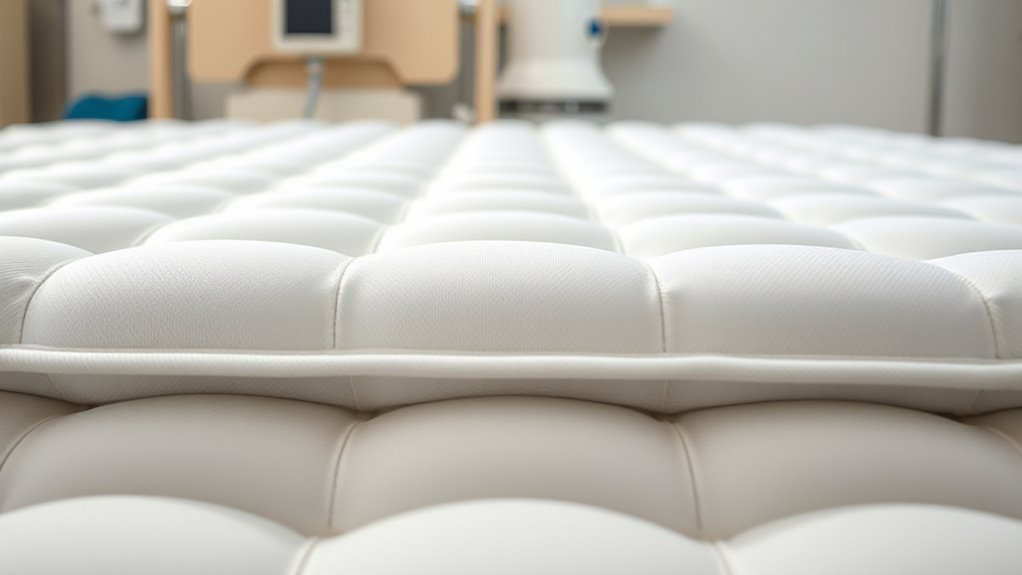
When selecting a low air loss mattress system, I focus on key factors like pressure redistribution technology and how easy it is to adjust. I also consider compatibility with the patient’s size and the system’s maintenance needs. Additionally, airflow and microclimate control are essential for ensuring ideal pressure relief and skin health.
Pressure Redistribution Technology
Pressure redistribution technology is a key factor to contemplate when selecting a low air loss mattress system for pressure relief. It works by using adjustable inflation and deflation cycles to evenly distribute body weight, reducing pressure points that can lead to ulcers. Many systems utilize multiple air cells that inflate and deflate alternately, minimizing shear and friction forces on the skin. Advanced features, like pulsation modes, intermittently pump air to boost blood flow and promote tissue healing. The cycle time typically ranges from 6 to 15 minutes, allowing customization based on patient needs and risk levels. Proper pressure redistribution technology not only helps prevent pressure ulcers but also supports wound healing by maintaining ideal microcirculation, making it essential in choosing the right mattress system.
Adjustability and Controls
Adjustability and controls play a pivotal role in optimizing pressure relief with low air loss mattress systems. Being able to customize pressure levels guarantees patient comfort while effectively redistributing pressure. Digital controls and LED displays make it easy to manage inflation, deflation, and cycle timing precisely. Variable cycle times, such as 10 to 25 minutes, let me tailor therapy to individual needs, enhancing comfort and healing. Some systems even feature adjustable airflow dials or modes targeting specific pressure points like heels or sacrum, improving localized relief. Remote control options are especially helpful, allowing caregivers to modify settings without disturbing the patient. Overall, intuitive controls and flexible adjustability are essential for ensuring effective, personalized pressure management and making the system user-friendly.
Size and Fit Compatibility
Choosing the right low air loss mattress system begins with guaranteeing it fits your bed and patient’s needs perfectly. First, double-check that the mattress dimensions match your bed size for proper support and pressure relief. It’s also essential to confirm the weight capacity aligns with your patient’s weight to avoid damage or inadequate support. Compatibility with existing bed frames or hospital beds ensures seamless integration and ease of use. Measure the available space in the patient’s environment, including room for the pump system, to prevent overcrowding. Finally, consider size options and adjustable features to accommodate different patient sizes and specific clinical needs. Proper sizing and fit are critical for optimizing pressure relief, comfort, and safety.
Ease of Maintenance
When selecting a low air loss mattress system, ease of maintenance plays a crucial role in ensuring consistent pressure relief and patient safety. I recommend choosing models with removable and replaceable air bladders, making cleaning and repairs straightforward. Look for mattresses with washable or easily wipeable covers to maintain hygiene and reduce cleaning time. Systems equipped with diagnostic alarms and user-friendly control panels help quickly identify issues, minimizing downtime. Durability is key—select mattresses made from robust materials resistant to wear and tear, which extends their lifespan and reduces repair needs. Additionally, opt for systems that are simple to set up and deflate, saving time for caregivers and ensuring the mattress is ready when needed. These features collectively streamline maintenance and enhance reliability.
Airflow and Microclimate
Ensuring proper airflow and microclimate management is essential for maximizing the pressure relief benefits of low air loss mattress systems. Effective airflow helps dissipate heat and moisture, maintaining a stable microclimate that minimizes skin maceration. Laser-perforated or vented air cells enable continuous ventilation, reducing humidity and supporting skin integrity. Proper regulation prevents sweat and moisture buildup, which are primary factors in skin breakdown and pressure ulcers. Adjustable air pressure and cycle settings allow customization to meet individual patient needs, optimizing comfort and skin health. A well-designed microclimate feature ensures consistent temperature and humidity levels, lowering infection risk and promoting faster wound healing. Focusing on airflow and microclimate management ensures the mattress system supports both pressure relief and overall skin well-being.
Noise Level and Comfort
A low noise level is essential for creating a peaceful environment that promotes restful sleep and minimizes caregiver disturbance. Whisper-quiet pumps operating at 22-28 dBA deliver effective pressure redistribution without disruptive noise, notably enhancing patient comfort. Noise levels above 35 dBA can interfere with sleep quality and may increase patient anxiety during therapy. Additionally, the pump’s operation stability matters; steady, quiet airflow reduces vibrations that can cause discomfort or disrupt rest. Many systems offer adjustable noise settings, allowing customization to suit individual sensitivities. This flexibility helps patients sleep better, aiding in healing and overall well-being. When selecting a low air loss mattress, prioritizing low noise levels ensures a more restful experience for patients and less disturbance for caregivers, creating a more comfortable and soothing environment.
Safety and Alarm Systems
How can you be confident that a low air loss mattress will keep your patient safe? Safety and alarm systems are crucial. These systems include low-pressure alarms and audible alerts that notify caregivers immediately if pressure drops or malfunctions occur. Automatic pressure regulation helps maintain consistent therapy, reducing the risk of skin breakdown without manual adjustments. Emergency deflation features, such as CPR valves, allow for rapid air release in urgent situations, ensuring patient safety. Monitoring systems with visual indicators and alarms provide real-time updates on system status, minimizing unnoticed failures. Diagnostic alarms and fail-safe mechanisms further ensure continuous therapy, reducing potential harm. These safety features give me peace of mind, knowing that the system actively protects patients and alerts staff promptly to any issues.
Durability and Material Quality
Choosing a low air loss mattress with durable and high-quality materials is essential for effective pressure relief and long-term performance. I look for mattresses made from medical-grade PVC or nylon, as these resist punctures, tears, and wear over time. The materials should also be heat- and water-resistant, making cleaning and sterilization straightforward and maintaining hygiene. Reinforced seams and leak-proof seals are critical to prevent air leaks, ensuring consistent therapy and extending the mattress’s lifespan. The core air cells need to be resilient and flexible, able to endure repeated inflation and deflation without degrading. Additionally, the overall build quality, including the pump and cover, influences the mattress’s ability to maintain stable pressure and withstand daily use in clinical or home environments.
Frequently Asked Questions
How Do Low Air Loss Mattresses Improve Circulation for At-Risk Patients?
Low air loss mattresses improve circulation by continuously redistributing pressure across the patient’s body and allowing air to flow underneath. This prevents blood vessels from becoming compressed, which reduces the risk of pressure sores and enhances blood flow. I’ve seen how this dynamic airflow and pressure adjustment keep at-risk patients more comfortable and healthier, promoting better circulation and faster healing, especially for those with limited mobility.
Are Low Air Loss Mattresses Suitable for Home Use or Only in Healthcare Settings?
Absolutely, low air loss mattresses can be used at home, not just in healthcare settings. Think of them as a gentle stream that eases pressure and boosts comfort—perfect for those at risk of sores or with mobility challenges. Many models are designed for easy setup and use, making them accessible for home care. If you’re considering one, just make sure it fits your needs and space, and you’re good to go.
What Maintenance Is Required to Ensure Optimal Performance of These Mattresses?
To keep your low air loss mattress performing well, I recommend regular inspections for leaks or tears, ensuring the air pump is clean and functioning properly. I also suggest checking and adjusting the air pressure as needed and cleaning the surface with mild disinfectants. Following the manufacturer’s guidelines for maintenance and scheduling professional checkups periodically helps prolong the mattress’s lifespan and maintains ideal pressure relief and comfort.
Can These Mattresses Be Customized for Specific Patient Weight or Size Needs?
Think of these mattresses like tailored suits—they can be adjusted for the perfect fit. Yes, many low air loss systems are customizable for specific patient weights or sizes. I’ve seen hospitals modify settings to guarantee patients of all shapes and sizes receive ideal pressure relief and comfort. Manufacturers often offer adjustable zones or customizable features, making it possible to personalize each mattress to meet individual needs effectively.
How Do Noise Levels Vary Among Different Low Air Loss Mattress Systems?
Noise levels in low air loss mattress systems vary depending on the model and brand. Some are whisper-quiet thanks to advanced air pump technology, while others can be slightly louder, especially during adjustments. I recommend checking product reviews and specifications to find a system that minimizes noise, so you or your patients stay comfortable and undisturbed. Quiet systems are essential for restful sleep and a peaceful environment.
Conclusion
Choosing the right low air loss mattress feels like finding the Excalibur of pressure relief—powerful, reliable, and tailored to your needs. With options that combine innovation and comfort, you can prevent wounds and enhance recovery, much like a knight safeguarding their kingdom. Remember, the best system isn’t just about technology but how it supports your well-being. So, equip yourself wisely—your comfort and health deserve nothing less than legendary protection.

